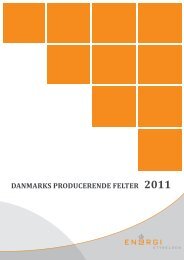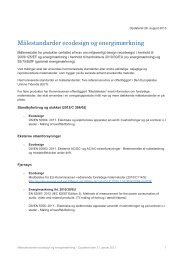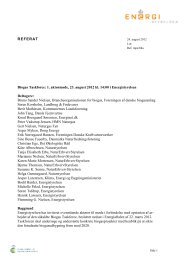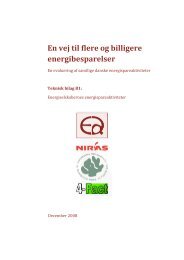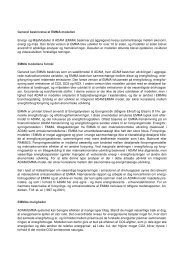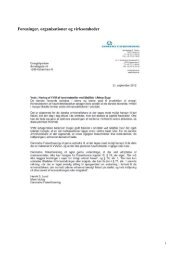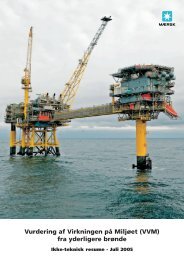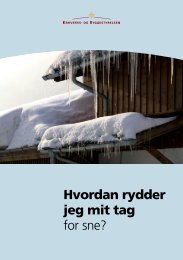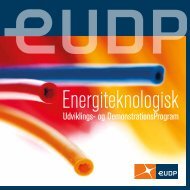Benthic Communities at Horns Rev Before, During and After Con
Benthic Communities at Horns Rev Before, During and After Con
Benthic Communities at Horns Rev Before, During and After Con
Create successful ePaper yourself
Turn your PDF publications into a flip-book with our unique Google optimized e-Paper software.
<strong>Horns</strong> <strong>Rev</strong>. <strong>Benthic</strong> communities Page 20<br />
100<br />
90<br />
80<br />
70<br />
60<br />
50<br />
40<br />
30<br />
20<br />
10<br />
0<br />
µmol/l Total Nitrogen<br />
1999 2000 2001 2002 2003 2004<br />
3.0<br />
2.5<br />
2.0<br />
1.5<br />
1.0<br />
0.5<br />
0.0<br />
µmol/l Total Phosphorous<br />
1999 2000 2001 2002 2003 2004<br />
Figure 1.2. Dissolved nutrient concentr<strong>at</strong>ions near <strong>Horns</strong> <strong>Rev</strong> (Blåv<strong>and</strong> west) 1999-2004 (NERI, 2006).<br />
Low transparency due to high amounts of re-suspended m<strong>at</strong>erial in the w<strong>at</strong>er column is<br />
characteristic for the <strong>Horns</strong> <strong>Rev</strong> area. High temporal variability is found in the w<strong>at</strong>er<br />
transparency, which is influenced by tidal current, wind induced current, current speed <strong>and</strong><br />
seasonal plankton dynamics. In general, the w<strong>at</strong>er transparency is low in spring, 1.8-6.0 in<br />
adjusted Secchi depth [Adjusted Secchi depth = estim<strong>at</strong>ed Secchi depth x (1+0.4 x wave<br />
height] <strong>and</strong> higher during autumn, 2.5-8.8. Pronounced diel variability in transparency is<br />
found within a few hours <strong>and</strong> is associ<strong>at</strong>ed with changes in the prevailing current directions<br />
from SSW to NNE (Bech et al., 2004; Bech et al., 2005; Leonhard & Pedersen,<br />
2004; Leonhard & Pedersen, 2005).<br />
1.3. <strong>Horns</strong> <strong>Rev</strong> Offshore Wind Farm<br />
<strong>Horns</strong> <strong>Rev</strong> Wind Farm is situ<strong>at</strong>ed south of the actual reef approxim<strong>at</strong>ely 14 km westsouth-west<br />
of Blåv<strong>and</strong>s Huk (Figure 1.3).<br />
a)<br />
b)<br />
524-E<br />
Bird area<br />
No.113<br />
qq qqq qqq qq<br />
q<br />
qq q qqq qqq<br />
qq qq qqq q qqq qqq<br />
qq q qqq qqq<br />
qq q q q q<br />
q<br />
q qq q q q qqq qqq qqq q<br />
q qq qqq qqq qqq<br />
524-D 524-C<br />
524-F<br />
524-B<br />
524-I<br />
524-A<br />
Bird area No.57<br />
q Wind turbines<br />
EU bird <strong>and</strong> habit<strong>at</strong> areas<br />
S<strong>and</strong> <strong>and</strong> gravel extraction areas<br />
Figure 1.3. The offshore wind farm <strong>at</strong> <strong>Horns</strong> <strong>Rev</strong> <strong>and</strong> the cable trace to l<strong>and</strong> <strong>at</strong> Hvidbjerg Str<strong>and</strong>. T marks the<br />
transformer pl<strong>at</strong>form (a). Areas for raw m<strong>at</strong>erial extraction <strong>and</strong> intern<strong>at</strong>ional protected bird <strong>and</strong><br />
habit<strong>at</strong> areas (b).<br />
The coordin<strong>at</strong>es of the outermost wind turbines <strong>and</strong> the transformer st<strong>at</strong>ion are shown in<br />
Appendix 1.<br />
1.3.1. <strong>Con</strong>struction <strong>and</strong> layout<br />
The offshore wind farm is comprised of 80 (Vestas V80- 2MV) wind turbines erected in a<br />
grid p<strong>at</strong>tern as shown in Figure 1.3. Thus, the total installed energy gener<strong>at</strong>ing capacity is<br />
160 MW. The distance between the individual wind turbines <strong>and</strong> rows is 560 m with the<br />
Doc. No. 2572-03-005 rev. 4




